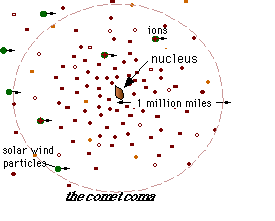Glycine, an amino acid, was discovered in a sample from a comet. This image shows four representations of glycine used by chemists.
Click on image for full size
Molecule model images courtesy of Ben Mills.
Stardust Finds Amino Acid in Comet Samples
In August 2009, scientists reported finding a type of amino acid in a sample returned from a comet. Amino acids are the building-blocks of proteins, one of the key molecules in living creatures. The comet sample was brought back to Earth by NASA's Stardust spacecraft in January 2006.
Some scientists think that complex molecules which may be precursors to life, like amino acids, might form in space and be brought to Earth by comets. If that is true, life on other planets could be more common than we think. That's why the discovery of an amino acid in the comet sample is interesting.
The sample is from Comet Wild 2, which Stardust flew by in January 2004. A team of researchers led by Dr. Jamie Elsila at NASA's Goddard Space Flight Center discovered the simplest amino acid, glycine, in the comet samples. The Stardust spacecraft collected the samples on a strange substance called aerogel as it flew through the tenuous atmosphere of the comet.
You might also be interested in:

In the warm primordial ocean, aggregates of amino acids, proteins, and other hydrocarbons coalesced into a form called *coacervates*. Organic polymers such as amino acids will spontaneously form coacervates
...more
The first beings were probably much like coacervates. As a group, these bacteria are called heterotrophic anaerobes. Because there was virtually no oxygen in the atmosphere at this time, these bacteria
...more
Comet Wild 2 is a short-period comet that orbits the Sun once every 6.39 years. A Swiss astronomer named Paul Wild discovered it on January 6, 1978. Wild 2 is pronounced "Vilt 2". The comet comes about
...more
The image on this page shows the best views we've ever had (so far) of the nucleus of a comet. On January 2, 2004, the Stardust spacecraft flew past Comet Wild 2 at a relative speed of roughly six kilometers
...more
NASA's Stardust mission was the first spacecraft to collect samples of material directly from a comet and return them to Earth. Stardust was launched by a Delta 2 rocket from Cape Canaveral Air Station,
...more
As the ices of the comet nucleus evaporate, they expand rapidly into a large cloud around the central part of the comet. This cloud, called the coma, is the atmosphere of the comet and can extend for millions
...more
In August 2009, scientists reported finding a type of amino acid in a sample returned from a comet. Amino acids are the building-blocks of proteins, one of the key molecules in living creatures. The comet
...more














